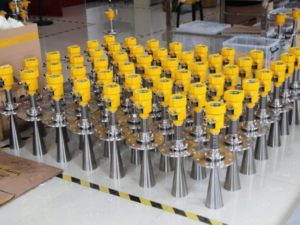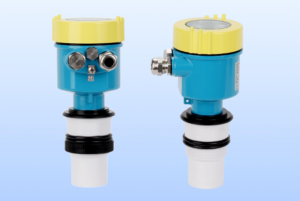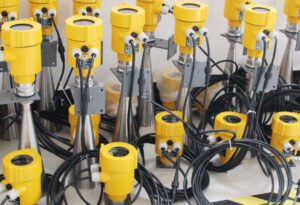When it comes to measuring liquid levels in industrial, commercial, or environmental settings, selecting the right technology can significantly impact performance, reliability, and cost-efficiency. Two common technologies used for level measurement are Radar Level Meters and Ultrasonic Level Meters. Both instruments offer unique advantages and are suitable for different environments. This article provides a detailed comparison to help you determine which technology best fits your specific needs.
1. Working Principles
- Radar Level Meter:
Radar meters use electromagnetic waves (microwaves) to measure the distance between the sensor and the liquid or solid surface. The meter sends these waves to the surface, and the reflection is measured to calculate the level based on the travel time of the wave. Radar meters operate at higher frequencies, typically between 6 GHz and 80 GHz, depending on the type. - Ultrasonic Level Meter:
Ultrasonic meters, on the other hand, use sound waves. The sensor emits a high-frequency sound wave toward the liquid’s surface. The sound wave reflects back, and the meter measures the time it takes for the wave to return to calculate the distance. Since sound waves travel at varying speeds depending on temperature and humidity, compensation mechanisms are required for accurate readings.
2. Accuracy and Performance
- Radar Level Meter:
- Offers high accuracy, typically within ±1 mm to a few millimeters.
- Not affected by temperature, pressure, or vapor, making it highly reliable in harsh environments.
- Ideal for applications where precise measurements are essential, such as chemical processes or high-value liquid storage.
- Ultrasonic Level Meter:
- Accuracy is generally within ±3 mm to 10 mm, which is sufficient for non-critical applications.
- Affected by environmental factors such as temperature, humidity, foam, and dust, which can introduce measurement errors.
- Performs well in relatively stable conditions, like water reservoirs, but may struggle with rapid temperature changes or vapors.
3. Applications and Environmental Suitability
- Radar Level Meter:
- Versatile: Can measure both liquids and solids (like powders or granules).
- Works well in challenging environments, such as high temperatures, high pressures, or environments with steam, vapors, or gases.
- Common applications include chemical storage tanks, distillation towers, and industrial silos.
- Ultrasonic Level Meter:
- Best suited for simple liquid level measurement in non-hazardous environments, such as water treatment plants or drainage systems.
- Works efficiently for open channels, reservoirs, or tanks, where precise measurements are not critical.
- Struggles with conditions that involve foam, vapor, or strong air currents, which can scatter or absorb sound waves.
4. Installation and Maintenance Requirements
- Radar Level Meter:
- Easy installation on the top of the tank or silo, with no need for contact with the material being measured.
- Requires minimal maintenance, as it is not exposed to material buildup or environmental wear.
- Suitable for remote monitoring, with options for wireless connectivity and integration into control systems.
- Ultrasonic Level Meter:
- Also easy to install, but the sensor may need periodic cleaning to prevent debris buildup on the surface.
- Can require more frequent calibration if environmental conditions vary significantly.
- Works well for short to medium range measurements, but accuracy can diminish over longer distances or in dusty environments.
5. Cost and Economic Considerations
- Radar Level Meter:
- Higher initial cost, but offers long-term reliability and minimal maintenance.
- Best for applications where accuracy and durability are essential, such as high-value material storage or process-critical operations.
- Ultrasonic Level Meter:
- Lower upfront cost, making it a cost-effective solution for less demanding applications.
- Ideal for budget-conscious projects or temporary installations where extreme accuracy is not required.
6. Pros and Cons of Radar and Ultrasonic Level Meters
| Aspect | Radar Level Meter | Ultrasonic Level Meter |
|---|---|---|
| Accuracy | High (±1 mm) | Medium (±3-10 mm) |
| Environmental Suitability | Unaffected by steam, dust, gas, or vapors | Affected by temperature, foam, vapor, and dust |
| Installation | Non-contact, minimal maintenance | Non-contact, may require periodic cleaning |
| Application | Liquids and solids, complex environments | Simple liquids, stable environments |
| Cost | Higher upfront cost, lower maintenance cost | Lower upfront cost, may require more maintenance |
| Range | Long-range capability, suitable for tall tanks/silos | Limited range, best for small to medium tanks |
7. Choosing the Right Technology: Key Takeaways
- When to Choose a Radar Level Meter:
- If high accuracy is critical for your process.
- When the environment involves high temperatures, pressure, or vapor.
- For industrial and chemical applications where reliability is essential.
- When measuring solids like powders or granular materials.
- When to Choose an Ultrasonic Level Meter:
- For non-critical liquid level measurement in simple environments.
- When budget constraints are a concern.
- For applications like water treatment plants, reservoirs, or drainage systems.
- If the environment is stable, with minimal interference from foam, vapor, or dust.
8. Conclusion
Both radar and ultrasonic level meters offer valuable solutions for different applications. Radar level meters excel in complex, high-stakes environments where accuracy and reliability are essential. They are suitable for industrial operations involving harsh conditions or multi-phase substances. Meanwhile, ultrasonic level meters are practical for simpler environments with stable conditions, offering a cost-effective solution for liquid level measurement.
Choosing the right level meter depends on your specific application requirements, environmental conditions, and budget. If you need precision, long-term reliability, and minimal maintenance, radar technology is the way to go. If your application is more straightforward and budget constraints are a concern, an ultrasonic level meter will meet your needs effectively.




